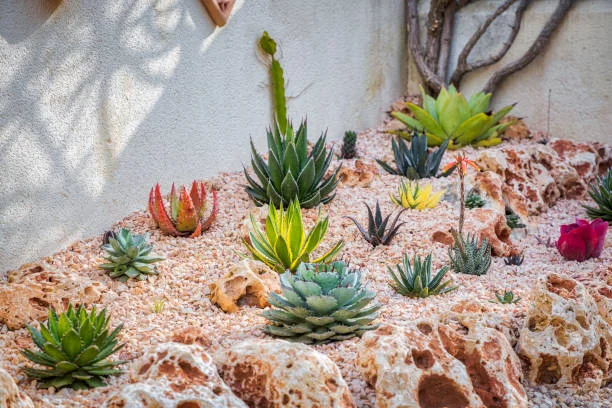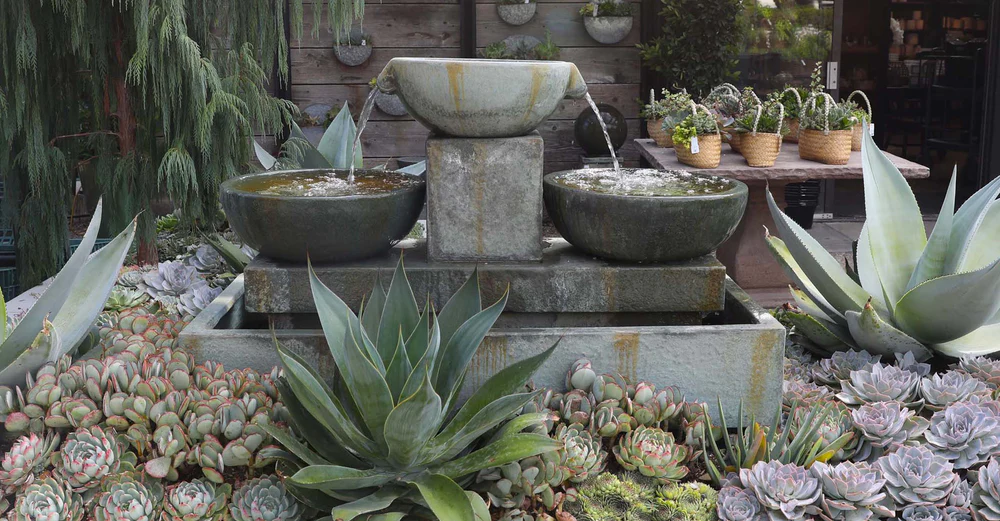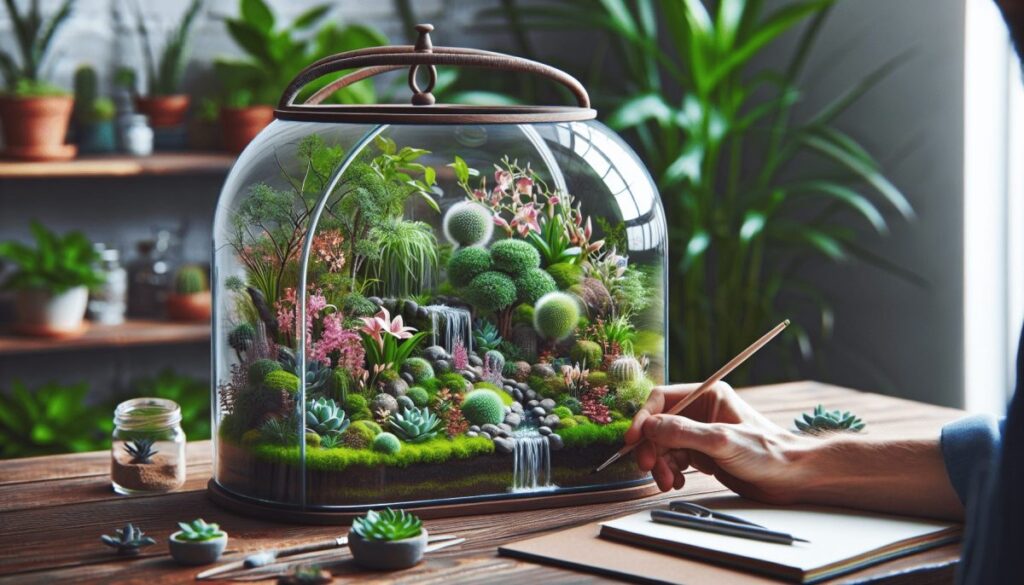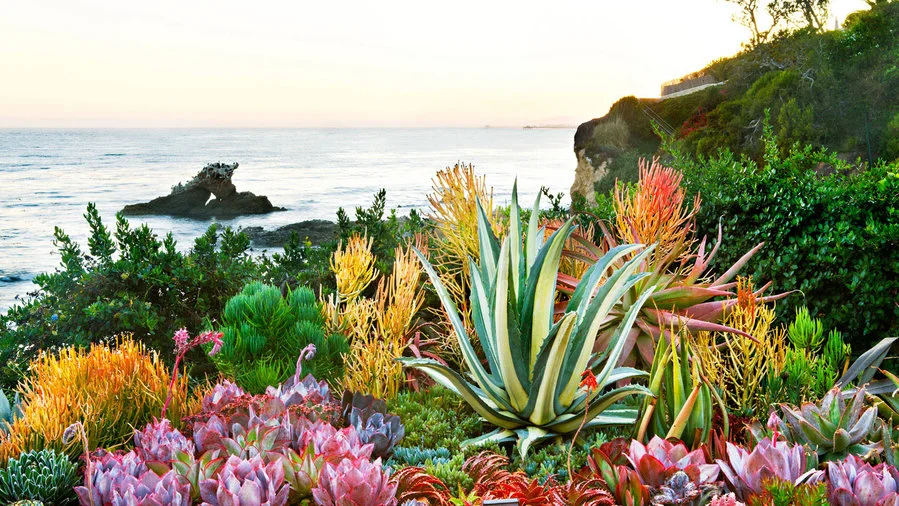Succulents are more than just a trendy houseplant—they’re a gardener’s best friend, especially for those looking to create a low-maintenance, drought-tolerant landscape. With their diverse shapes, colors, and textures, succulents can transform any yard into a stunning oasis. Whether you have a small patio or a sprawling garden, these 10 succulent landscape design ideas will inspire you to bring a unique and sustainable beauty to your outdoor space.
1. Vertical Succulent Gardens
What is a Vertical Succulent Garden?

A vertical succulent garden is an innovative way to maximize space while creating a visually striking feature in your yard. These gardens involve growing succulents on walls, fences, or other vertical structures, turning them into living art pieces.
Benefits of Vertical Succulent Gardens
- Space-Saving: Ideal for small yards or patios where ground space is limited.
- Visual Appeal: Adds height and dimension to your garden, making it more dynamic.
- Low Maintenance: Vertical gardens are easy to care for, with succulents requiring minimal water and attention.
Tips for Creating a Vertical Succulent Garden
- Choose the Right Location: Ensure the wall or fence receives adequate sunlight, as succulents thrive in bright light.
- Select Appropriate Succulents: Opt for varieties like Sedum, Echeveria, or String of Pearls, which are well-suited for vertical growth.
- Use Vertical Planters or Frames: Specialized planters designed for vertical gardening will help your succulents stay securely in place and maintain proper drainage.
2. Succulent Rock Gardens
Combining Succulents and Rocks for a Natural Landscape

Succulent rock gardens mimic the natural arid landscapes where these plants thrive. By combining succulents with various sizes of rocks and stones, you can create a rustic, earthy look that blends seamlessly with the environment.
Design Ideas for a Succulent Rock Garden
- Layering Techniques: Start with larger rocks as a base, then gradually add smaller stones around your succulents for a balanced, natural appearance.
- Decorative Elements: Incorporate elements like driftwood, pebbles, or small sculptures to add character and texture to your rock garden.
Best Succulents for Rock Gardens
Succulents like Agave, Sempervivum (Hens and Chicks), and Aloe are excellent choices for rock gardens due to their resilience and unique forms.
3. Succulent Ground Covers
Transform Your Yard with Succulent Ground Covers

Using low-growing succulents as ground covers is an excellent way to create a lush, green carpet that requires minimal care. These plants spread easily, suppress weeds, and add a cohesive look to your landscape.
Advantages of Succulent Ground Covers
- Weed Suppression: Dense succulent ground covers prevent weeds from taking root, reducing the need for manual weeding.
- Erosion Control: Succulents stabilize the soil, making them ideal for sloped areas prone to erosion.
- Uniform Appearance: A blanket of succulents creates a unified look, perfect for large, open spaces.
Top Succulents for Ground Cover
Consider planting varieties like Sedum, Delosperma (Ice Plant), or Othonna capensis (Little Pickles) for vibrant, low-maintenance ground coverage.
4. Succulent and Cactus Combinations

Integrate Succulents with Cacti for a Textured Garden
Pairing succulents with cacti can create a garden full of texture, contrast, and visual interest. Both plant types are drought-resistant, making them ideal companions in a xeriscaped yard.
Design Principles for Succulent and Cactus Gardens
- Balance Shapes and Sizes: Use taller cacti as focal points, with lower-growing succulents filling in the gaps.
- Color Coordination: Mix green, blue, purple, and red succulents with the varied hues of cacti to create a vibrant display.
Care Tips for Mixed Succulent and Cactus Gardens
While both cacti and succulents are drought-tolerant, they have slightly different water needs. Ensure proper drainage and avoid overwatering to keep both plant types healthy.
5. Succulent Pathways
Create Inviting Walkways with Succulent Pathways

Succulent pathways add charm and functionality to your garden, guiding visitors through your yard while showcasing the beauty of these hardy plants.
Design Ideas for Succulent Pathways
- Incorporate Stepping Stones: Use large, flat stones as stepping paths, with succulents like Creeping Thyme or Sedum planted between them.
- Texture Variation: Mix different succulent varieties along the pathway for a diverse and textured look.
- Create Borders: Line the edges of your path with taller succulents like Aloe or Agave to create a natural border.
Maintenance Tips for Succulent Pathways
Ensure that the pathway is well-drained to prevent water accumulation, which can damage the succulents. Regularly prune any overgrown plants to keep the path clear and accessible.
6. Succulent Planters and Pots

Showcase Succulents in Stylish Planters
Succulent planters are a versatile and creative way to display these plants in your yard. Whether you prefer hanging pots, traditional planters, or repurposed containers, the possibilities are endless.
Creative Planter Ideas
- Hanging Planters: Perfect for patios or balconies, hanging planters allow you to create cascading succulent arrangements.
- Repurposed Containers: Give old items like teapots, boots, or birdbaths a new life by turning them into unique succulent planters.
- Mixed Arrangements: Combine different succulent varieties in one pot to create a miniature garden with contrasting colors and textures.
Best Practices for Succulent Planters
Use a well-draining soil mix specifically designed for succulents. Ensure your planters have drainage holes to prevent waterlogged roots, and place them in a spot that receives plenty of sunlight.
7. Succulent Water Features
Combine Succulents with Water Elements

Incorporating succulents into your garden’s water features, like fountains or ponds, adds a refreshing contrast between dry and wet elements, creating a tranquil and unique garden design.
Design Tips for Succulent Water Features
- Positioning Plants: Place succulents near the edges of water features where they can benefit from the humidity without being submerged.
- Aquatic Integration: Combine succulents with aquatic plants like water lilies or lotus to enhance the visual appeal of your water feature.
Care Considerations
While succulents thrive in dry conditions, the added moisture from a water feature can be beneficial as long as the roots are not waterlogged. Use gravel or sand around the succulents to improve drainage.
8. Succulent Terrariums and Mini-Gardens
Create Miniature Landscapes with Succulent Terrariums

Succulent terrariums are perfect for adding a touch of greenery to small spaces. These miniature gardens can be customized to fit any theme or style, making them a fun and creative project.
Design Ideas for Succulent Terrariums
- Layering Techniques: Start with a layer of pebbles or sand for drainage, followed by succulent soil, and top it off with decorative rocks or moss.
- Themed Terrariums: Create themed mini-gardens, such as a desert landscape with cacti and succulents, or a whimsical fairy garden with tiny figurines.
Care Guidelines
Succulents in terrariums require minimal water—just a light misting every few weeks. Place the terrarium in a bright spot but avoid direct sunlight to prevent overheating.
9. Coastal Succulent Gardens
Design Succulent Gardens for Coastal Climates

Coastal gardens can present challenges due to salty air, sandy soil, and strong winds, but succulents are well-adapted to thrive in these conditions. With the right design elements, you can create a resilient and beautiful coastal succulent garden.
Design Elements for Coastal Succulent Gardens
- Incorporate Driftwood and Sand: Use driftwood as a natural sculpture and sand to create a beach-like atmosphere in your garden.
- Windbreaks: Plant taller succulents like Agave or Aloe as windbreaks to protect smaller, more delicate plants.
Best Succulents for Coastal Gardens
Choose salt-tolerant varieties like Carpobrotus (Ice Plant), Senecio mandraliscae (Blue Chalksticks), and Aeonium, which can withstand the harsh coastal environment.
10. Succulent Focal Points and Sculptures
Create Stunning Focal Points with Succulent Sculptures

Succulent focal points or living sculptures can become the centerpiece of your garden. These artistic arrangements draw attention and add a wow factor to your landscape.
Design Ideas for Succulent Sculptures
- Succulent Spheres: Create a spherical arrangement by planting succulents in a wireframe or moss ball, perfect for hanging or placing on pedestals.
- Spirals and Shapes: Arrange succulents in spirals, heart shapes, or other patterns to create eye-catching garden features.
Maintenance Tips for Succulent Sculptures
Regularly prune your succulent sculptures to maintain their shape and ensure they don’t become overgrown. Water sparingly to prevent rot, especially if the sculpture is dense or tightly packed.
Conclusion
Transforming your yard with succulents is not only aesthetically pleasing but also practical and environmentally friendly. Whether you choose to create a vertical garden, design a succulent pathway, or integrate succulents into your water features, these versatile plants will thrive with minimal effort. Start experimenting with

